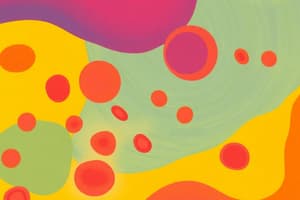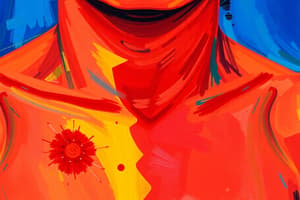Podcast
Questions and Answers
Which characteristic is most indicative of urticaria?
Which characteristic is most indicative of urticaria?
- Chronic lesions lasting more than 48 hours
- Presence of scales on the skin lesions
- Non-blanching purpuric lesions
- Intense pruritus associated with superficial dermal edema. (correct)
A patient presents with urticaria-like lesions. Which finding would suggest urticarial vasculitis instead?
A patient presents with urticaria-like lesions. Which finding would suggest urticarial vasculitis instead?
- The lesions are intensely pruritic
- Lesions resolve within 24 hours.
- The lesions leave residual bruising. (correct)
- The lesions are well-demarcated.
Which of the following is the most appropriate initial treatment for acute urticaria?
Which of the following is the most appropriate initial treatment for acute urticaria?
- Topical corticosteroids
- Systemic corticosteroids
- Second-generation H1 antihistamines (correct)
- First-generation H1 antihistamines
In evaluating a patient with urticaria, which historical detail would be most helpful in identifying a potential allergic trigger?
In evaluating a patient with urticaria, which historical detail would be most helpful in identifying a potential allergic trigger?
What is the primary mechanism behind urticaria formation?
What is the primary mechanism behind urticaria formation?
Which of these skin lesion descriptions best defines a 'wheal' as seen in urticaria?
Which of these skin lesion descriptions best defines a 'wheal' as seen in urticaria?
A patient's urticaria is triggered by scratching their skin. What term describes this condition?
A patient's urticaria is triggered by scratching their skin. What term describes this condition?
Which diagnostic approach is most recommended in evaluating urticaria?
Which diagnostic approach is most recommended in evaluating urticaria?
What is a key difference between acute and chronic urticaria?
What is a key difference between acute and chronic urticaria?
A patient with a history of urticaria develops lip and tongue swelling and difficulty breathing. What immediate treatment is required?
A patient with a history of urticaria develops lip and tongue swelling and difficulty breathing. What immediate treatment is required?
In which type of hypersensitivity reaction does Mast Cell Dependent & IgE Dependent urticaria fall?
In which type of hypersensitivity reaction does Mast Cell Dependent & IgE Dependent urticaria fall?
Which of the following is an example of urticaria whose identifiable cause is an IgE-mediated allergic reaction?
Which of the following is an example of urticaria whose identifiable cause is an IgE-mediated allergic reaction?
Which of the following is an example of urticaria whose identifiable cause is a physical stimuli?
Which of the following is an example of urticaria whose identifiable cause is a physical stimuli?
A patient presents with urticaria, and the determination is made that it's been caused by direct mast cell activation. Which of the following can be the identifiable cause?
A patient presents with urticaria, and the determination is made that it's been caused by direct mast cell activation. Which of the following can be the identifiable cause?
In the step-wise treatment of chronic urticaria, if a H1 antihistamine is insufficient, what is the next step?
In the step-wise treatment of chronic urticaria, if a H1 antihistamine is insufficient, what is the next step?
Which of the following describes Chronic Inducible Urticaria (CIU)?
Which of the following describes Chronic Inducible Urticaria (CIU)?
Urticaria commonly presents as intensely pruritic wheals and can be caused by:
Urticaria commonly presents as intensely pruritic wheals and can be caused by:
In anaphylaxis, which of the following describes one of the skin symptoms?
In anaphylaxis, which of the following describes one of the skin symptoms?
A patient has been determined to have viral exanthem. What is a determining symptom?
A patient has been determined to have viral exanthem. What is a determining symptom?
A patient has been determined to have Pityriasis rosea. What is a determining symptom?
A patient has been determined to have Pityriasis rosea. What is a determining symptom?
Which of the following is NOT a skin lesion type (Primary Morphology)?
Which of the following is NOT a skin lesion type (Primary Morphology)?
Which of the following describes skin lesion in which there's superficial elevated solid less than 0.5cm whose color varies?
Which of the following describes skin lesion in which there's superficial elevated solid less than 0.5cm whose color varies?
A patient describes their skin lesion as linear erosion. Which of the following describes that?
A patient describes their skin lesion as linear erosion. Which of the following describes that?
Which of the following lesion descriptors means 'ring-shaped'?
Which of the following lesion descriptors means 'ring-shaped'?
True or False: The first-line pharmacotherapy is second-generation H₁ antihistamines, which can be titrated to greater than standard doses. First-generation H₁ antihistamines, H2 antihistamines, leukotriene receptor antagonists, high-potency antihistamines, and brief corticosteroid are often used as the first line.
True or False: The first-line pharmacotherapy is second-generation H₁ antihistamines, which can be titrated to greater than standard doses. First-generation H₁ antihistamines, H2 antihistamines, leukotriene receptor antagonists, high-potency antihistamines, and brief corticosteroid are often used as the first line.
Which of the following is recommended for treating acute angioedema?
Which of the following is recommended for treating acute angioedema?
Which of the following is considered a miscellaneous mechanism that identifies the causes of urticaria?
Which of the following is considered a miscellaneous mechanism that identifies the causes of urticaria?
What is the recommended diagnostic test for Symptomatic dermographism (urticaria factitia)?
What is the recommended diagnostic test for Symptomatic dermographism (urticaria factitia)?
A patient notes that an allergy test came back suggesting a possible allergy. Which of the following describes how to interpret this test?
A patient notes that an allergy test came back suggesting a possible allergy. Which of the following describes how to interpret this test?
Flashcards
Urticaria Definition
Urticaria Definition
Rash of red welts due to MAST CELL DEGRANULATION
Macule
Macule
Flat lesion less than 1 cm, without elevation or depression
Patch
Patch
Flat lesion greater than 1 cm, without elevation or depression
Plaque
Plaque
Signup and view all the flashcards
Papule
Papule
Signup and view all the flashcards
Nodule
Nodule
Signup and view all the flashcards
Vesicle
Vesicle
Signup and view all the flashcards
Pustule
Pustule
Signup and view all the flashcards
Bulla
Bulla
Signup and view all the flashcards
Wheal
Wheal
Signup and view all the flashcards
Acute vs. Chronic Urticaria
Acute vs. Chronic Urticaria
Signup and view all the flashcards
Chronic Urticaria
Chronic Urticaria
Signup and view all the flashcards
Chronic Inducible Urticaria (CIU)
Chronic Inducible Urticaria (CIU)
Signup and view all the flashcards
Mast Cell Dependant & IgE Dependant
Mast Cell Dependant & IgE Dependant
Signup and view all the flashcards
Mast Cell Dependant BUT IgE Independent
Mast Cell Dependant BUT IgE Independent
Signup and view all the flashcards
Mast Cell & IgE Independent
Mast Cell & IgE Independent
Signup and view all the flashcards
Infections Causing Urticaria
Infections Causing Urticaria
Signup and view all the flashcards
IgE-mediated causes of Urticaria
IgE-mediated causes of Urticaria
Signup and view all the flashcards
Direct mast cell activators
Direct mast cell activators
Signup and view all the flashcards
Physical Stimuli
Physical Stimuli
Signup and view all the flashcards
Anaphylaxis Neurologic Symptoms
Anaphylaxis Neurologic Symptoms
Signup and view all the flashcards
Urticaria Evaluation Begins with…
Urticaria Evaluation Begins with…
Signup and view all the flashcards
Arthropod bites
Arthropod bites
Signup and view all the flashcards
First-line Urticaria Treatment
First-line Urticaria Treatment
Signup and view all the flashcards
Urticaria Treatment
Urticaria Treatment
Signup and view all the flashcards
Angioedema treatment
Angioedema treatment
Signup and view all the flashcards
Study Notes
- Urticaria is commonly known as hives.
- Kelsey Reindel, D.O. is presenting on this topic
Lecture Objectives
- Discuss the etiology, evaluation, diagnosis, and treatment of acute urticaria
- Discuss the etiology, evaluation, diagnosis, and treatment of chronic urticaria
Primary Morphology (Lesion Type)
- Macule is a flat lesion less than 1 cm, without elevation or depression
- Patch is a flat lesion greater than 1 cm, without elevation or depression
- Plaque is a flat, elevated lesion, usually greater than 1 cm
- Papule is an elevated, solid lesion less than 1 cm
- Nodule is an elevated, solid lesion greater than 1 cm
- Vesicle is an elevated, fluid-filled lesion, usually less than 1 cm
- Pustule is an elevated, pus-filled lesion, usually less than 1 cm
- Bulla is an elevated, fluid-filled lesion, usually greater than 1 cm
- Size varies
- Demarcation can be well-demarcated or not well-demarcated
- Colors can be white, red, purple, brown, yellow, black, or blue
Secondary Morphology
- Serum (Dry crust)
- Fissure
- Lichenification
- Erosion
- Ulceration
- Scaling
- Wheal
- Distribution can be extensor, generalized, or photodistributive
Defining Urticaria
- Size is various
- Color is Erythematous (red)
- Demarcation is Well-Demarcated
- Distribution on the trunk, extremities, and areas exposed to pressure
- Shape Polycyclic, Annular, or Geographic
- Morphology is Annular/Polycyclic, Erythematous, Well-Demarcated, Transient, Edematous Plaque without Scaling and a notable flare (Wheal)
- Round - nummular, discoid (shape)
- Annular is ring-shaped (shape, configuration, grouping)
- Arcuate - part of a ring, arc-shaped (shape, configuration, grouping)
- Concentric - rings within rings (configuration)
- Polycyclic - formed from confluent annuli (configuration)
- Gyrate - forms spirals (configuration)
- Figurate - figure-forming (shape, configuration)
- Linear - forms a line (shape, configuration, grouping)
- Serpiginous - wavy, snake-like (shape, configuration, grouping)
- Whorled - forms swirls (shape, configuration)
- Reticulate - retiform, net-like, lacy (shape, configuration)
- Herpetiform - herpes-like (configuration, grouping)
- Agminate - clustered (grouping)
- Rash of round, red welts on the skin that forms after Mast Cell Degranulation
- Characterized by superficial Dermal edema
- Intensely Pruritic
- May or may not be associated with Angioedema
- A fleeting time course (30 minutes to 24 hours) with skin returning to normal
- Can be Acute, Chronic, or Physical
Pathophysiology
- Mast Cell Dependant & IgE Dependant:
- Drugs
- Pollens
- Foods
- Insect Stings
- Latex
- Parasitic
- Mast Cell Dependant, IgE Independent:
- Opiates
- Antibiotics- Vancomycin
- Curare
- Muscle Relaxants
- Radiographic Contrast
- “Stinging Nettle”
- Mast Cell & IgE Independent:
- Hereditary Angioneuritic Edema
- Aspirin
- Type 1 Hypersensitivity Reactions
- Requires exposure to a protein that is large enough to serve as an antigen
- Intradermal edema due to Capillary and Venous Vasodilation: -- Histamine -- Bradykinin -- Vasoactive Chemicals
- Non-immune mediated mast cell activation:
- Direct nonallergic activation of mast cells (antigens act directly on mast cell instead of on the IgE Receptor)
Identifiable causes of urticaria:
- Infections Viral Parasitic Bacterial
- IgE-mediated allergic cases: Medications Insects: -- Stinging (yellow jackets, bees, wasps, hornets, fire ants) -- Biting (Triatoma [kissing bugs]) Foods Blood products (urticarial transfusion reaction) Latex (contact or inhaled) Contact allergens (animal saliva, raw foods) Aeroallergens (rare) Food additives
- Direct mast cell activation: Narcotics/opiates Muscle relaxants (eg, succinylcholine) Radiocontrast agents Vancomycin
- Physical stimuli: Dermatographism Delayed pressure Cold Cholinergic Vibratory Aquagenic Solar Exertion/exercise
- Miscellaneous mechanisms: Nonsteroidal anti-inflammatory drugs Serum sickness Transfusion reactions (distinct from IgE-mediated reactions) Hormone-associated (progesterone) Stinging nettle
- IgE: immunoglobulin E.
Main Types of Urticaria
- Acute:
- <6 weeks duration
- Often relieved within hours to days
- A trigger is usually easily identified
- Food, insect bites, drug reaction, infection
- Chronic
- Recurrent
- Signs and symptoms recurring on most days of the week for >6 weeks
- Most often Idiopathic
Chronic Urticaria
- Chronic Spontaneous Urticaria (CSU):
- Greater than 6 weeks
- Signs and Symptoms recurring on most days of the week
- No specific cause or trigger
- Can have associated Headache, Fatigue, Joint Pain, GI symptoms
- There is a strong association between chronic spontaneous urticaria and other immune disorders, particularly autoimmune thyroid disease.
- Epidemiology:
- CSU affects ~1% of the US population, believed to be similar worldwide.
- Affects males and females
- Females >> males
- Children & adults can suffer from CSU; however, it's more prevalent in the third to fifth decade of life.
- Chronic Inducible Urticaria (CIU)
- Greater than 6 weeks
- Signs and Symptoms recurring on most days of the week
- Commonly, these stimuli that provoke weals to develop include stroking or scratching the skin (dermographism), exercise, and emotional upset (cholinergic urticaria).
- Less common forms of chronic inducible urticaria are triggered by cold, heat, pressure, sunlight (solar urticaria), contact with water or various chemicals (contact urticaria), or vibration.
- Epidemiology:
- CSU affects ~2% of the US population, believed to be similar worldwide.
- Affects males and females
- Females >> males
Physical Urticaria
- Inciting factors and diagnostic tests for physical and other inducible urticarias:
- Symptomatic dermographism (urticaria factitia): -- Inciting Trigger: Firm stroking, scratching, pressure -- Diagnostic Test: Moderate stroking of the skin with a blunt, smooth object or dermographometer.
- Delayed-pressure urticaria/angioedema -- Inciting Trigger: Application of pressure 0.5 to 12 hours before onset of symptoms -- Diagnostic Test: Sling with weights placed over arm or shoulder for 15 minutes. Patient reports symptoms over the next 24 hours.
- Cholinergic urticaria -- Inciting Trigger: Elevation of body temperature (exercise, hot water, strong emotion, hot or spicy food) -- Diagnostic Test: Exercise using a machine to the point of sweating, then continue for 15 minutes. Then, passive heating of one/both arms in 42°C warm water bath to cause an increase in body temperature of ≥1°C
- Cold contact urticaria -- Inciting Trigger: Exposure of skin to cold air, cold liquids, or cold objects -- Diagnostic Test: Ice cube test - Melting ice cube in thin plastic bag for 5 minutes.
- Heat contact urticaria -- Inciting Trigger: Warm object in direct contact with the affected skin -- Diagnostic Test: Application of a test tube containing 45°C water or a metal cylinder heated to 45°C to skin for 5 minutes.
- Exercise-induced urticaria/anaphylaxis -- Inciting Trigger: Physical exertion -- Diagnostic Test: Treadmill testing
- Aquagenic urticaria -- Inciting Trigger: Skin contact with water of any temperature -- Diagnostic Test: Application of 35°C water in compress to upper body for 30 minutes.
- Solar urticaria -- Inciting Trigger: Exposure of skin to sunlight (triggering wavelengths vary) -- Diagnostic Test: Exposure of normally covered skin to UVA , UVB, and visible light (projector)
- Vibratory urticaria/angioedema -- Inciting Trigger: Lawn mowing, riding a motorcycle, horseback riding, mountain biking, exposure to vibrating machinery, holding some steering wheels -- Diagnostic Test: Vortex mixer is held against the skin for 10 minutes.
Evaluation
- Usually Always Clinical
- The first step in evaluating urticaria and angioedema is a history and physical examination to characterize the lesions and help identify causes
- "Hives" is often used nonspecifically
- Check if the patient had hives in the past or other allergic disorders
- Is there any signs of systemic disease? -- Unexplained fever, weight loss, arthralgias, arthritis, bone pain
- Is there a possible etiology from the patient's history?
- Was the patient in his/her usual state of health? Any recent bacterial or viral infections?
- Any recent MSK complaints for which NSAIDs may have been used? -Recent travel (Parasitic infection)
- Sexual History
- Previous recent food, drink, exercise, physical activity, temperatures, insect bites, supplements or medications
- Physical examination -- Vital signs -- Anaphylaxis? -- Lesions should always be visualized -- Showing the patient a photo of wheal/hives can sometimes help -- Asking the patient if they took photos of the lesion
- Symptoms and signs of anaphylaxis: -- Skin :Feeling of warmth, flushing (erythema), itching, urticaria, angioedema, and "hair standing on end" (pilor erection) -- Oral : Itching or tingling of lips, tongue, or palate, Edema of lips, tongue, uvula, metallic taste -- Respiratory : Nose- Itching, congestion, rhinorrhea, and sneezing, Laryngeal, Itching and "tightness" in the throat, dysphonia, hoarseness, stridor, Lower airways - Shortness of breath (dyspnea), chest tightness, cough, wheezing, and cyanosis -- Gastrointestinal : Nausea, abdominal pain, vomiting, diarrhea, and dysphagia (difficulty swallowing) -- Cardiovascular : Feeling of faintness or dizziness; syncope, altered mental status, chest pain, palpitations, tachycardia, bradycardia or other dysrhythmia, hypotension, tunnel vision, difficulty hearing, urinary or fecal incontinence, and cardiac arrest -- Neurologic : Anxiety, apprehension, sense of impending doom, seizures, headache and confusion; young children may have sudden behavioral changes (cling, cry, become irritable, cease to play) -- Ocular: Periorbital itching, erythema and edema, tearing, and conjunctival erythema -- Other Uterine cramps in women and girls
Laboratory Work-Up
- Laboratory workup is not necessary in the absence of indications of an underlying cause
- Targeted testing is appropriate if the history or physical examination suggests a specific cause or underlying disease
- Allergy testing is not recommended unless there is a specific indication of an allergic cause
- An allergic cause is possible if the clinical history reveals a specific trigger
- A specific IgE blood test can be ordered - a positive result is suggestive, although not diagnostic, of allergy, and a negative result does not exclude allergy
- Skin tests with fresh food/allergen can be performed by an allergy specialist, are probably the most convenient, inexpensive, and sensitive ways to detect food hypersensitivity
Differential Diagnosis (Pruritic)
- Conditions That May Be Confused with Urticaria:
- Arthropod bites: Lesions lasting several days, insect exposure history
- Atopic dermatitis: Maculopapular, scaling, characteristic distribution
- Bullous pemphigoid: Lesions lasting more than 24 hours, blistering, Nikolsky sign (light friction causes erosion or vesicle)
- Contact dermatitis: Indistinct margins, papular, persistent lesions, epidermal component present
- Erythema multiforme: Lesions lasting several days, iris-shaped papules, target appearance, may have fever
- Mastocytosis and diffuse cutaneous: Normal to yellow-brown skin color, diffuse thickening, bullae
- Morbilliform drug reactions: Maculopapular, associated with medication use
Differential Diagnosis (Non-Pruritic)
- Pityriasis rosea: Lesions lasting weeks, herald patch, Christmas tree pattern, often not pruritic
- Viral exanthem: Not pruritic, prodrome, fever, maculopapular lesions, individual lesions lasting days
- Henoch-Schönlein purpura: Lower extremity distribution, purpuric lesions, systemic symptoms
- Urticarial Vasculitis: should be considered when the hives are painful rather than pruritic, last longer than 48 hours, leave residual bruising or pigmentation changes, or recur whenever glucocorticoids are tapered
Urticaria Treatment
- Avoidance of Triggers
- 2nd generation H1 antihistamines PRN(Cetirizine, Levocetirizine, loratadine, desloratadine, fexofenadine) are first-line medication for the treatment of acute urticaria -- 1st generation? -- Lipophilic and readily cross the blood-brain barrier – sedation, Diphenhydramine, chlorpheniramine, hydroxyzine
- If symptoms are uncontrolled with 2nd generation H1 antihistamines, H2 antihistamines such as cimetidine (Tagamet), famotidine (Pepcid), and ranitidine (Zantac) may be added
- In severe cases, corticosteroids such as prednisone or prednisolone may be added for three to 10 days to control symptoms
Urticaria with Angioedema Treatment
- Treatment of acute angioedema is largely the same as treatment for urticaria, although corticosteroids may be more commonly recommended
- Angioedema of the larynx and massive angioedema of the tongue are medical emergencies. Require IM epinephrine and airway management
- Patients with angioedema that previously threatened airway compromise should be prescribed epinephrine autoinjectors
Chronic Urticaria Treatment
- Step 1: Start second-generation H₁ antihistamine, if insufficient control proceed to step 2
- Step 2: One or more of the following: -- Titrate second-generation H₁ antihistamine to two to four times normal dose -- Add a different second-generation H₁ antihistamine -- Add H₂ antihistamine -- Add first-generation H₁ antihistamine at night -- Add leukotriene receptor antagonist
- Step 3: Add high-potency antihistamine hydroxyzine or doxepin and titrate as tolerated, if insufficient control proceed to step 4
- Step 4: Consider referrals for immunomodulatory therapy such as omalizumab (Xolair) or cyclosporine (Sandimmune)
- Avoidance of Triggers
- CSU is episodic & self limited
- The average duration of disease is two to five years, patients without a trigger or underlying disorder identified has a rate of spontaneous remission at one year of approximately 30 to 50 percent
- Inducing tolerance can be useful in cold urticaria, cholinergic urticaria, and solar urticaria. Tolerance induction lasts only a few days, and consistent daily exposure is required to maintain tolerance
Summary
- Urticaria presents with intensely pruritic wheals, sometimes subcutaneous or interstitial tissue edema
- Lifetime prevalence of about 20%, often self-limited/benign, causes significant discomfort, continuemonths to years, uncommonly represent a serious systemicdisorder/life-threatening allergic reaction
- Urticaria is caused by immunoglobulin E- and non-immunoglobulin E-mediated release of histamine and other inflammatory mediators from mast cells and basophils
- Diagnosis is made clinically; anaphylaxis must be ruled out. Chronic urticaria is idiopathic in 80% to 90% of cases
- Only a limited nonspecific laboratory workup should be considered
- The mainstay of treatment is avoidance of triggers, if identified
- The first-line pharmacotherapy is second-generation H₁ antihistamines, which can be titrated to greater than standard doses
- First-generation H₁ antihistamines, H₂ antihistamines, leukotriene receptor antagonists, potent antihistamines, and brief corticosteroid bursts may be used as adjunctive treatment
- For refractory chronic urticaria, patients can be referred to subspecialists
- More than one-half of patients with chronic urticaria will have resolution or improvement of symptoms within a year
Studying That Suits You
Use AI to generate personalized quizzes and flashcards to suit your learning preferences.




